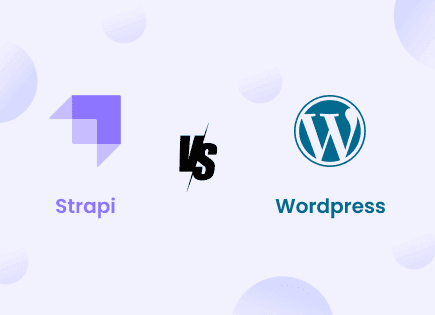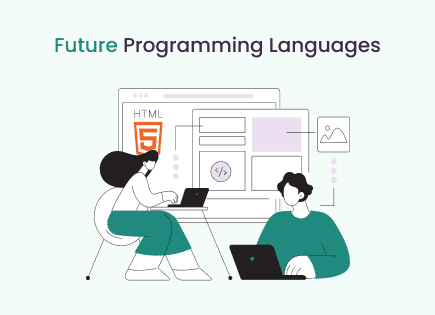Table of Content
Top 10 Backend Frameworks You Must Know in 2025
Table of Content

Are you looking to develop a groundbreaking mobile or web app but don’t know which backend framework to choose? Are you confused about which backend framework will best suit your development needs?
Don’t worry, we’re here to help!
A backend framework comprises libraries, conventions, and tools. It helps you streamline your server-side development for web and mobile applications.
Here’s a popular way of understanding the importance of a backend framework. If someone asks you to cut a 5” by 5” frame, you could do so manually by measuring a piece of paper. However, what if someone asked you to cut 1,000 of them?
You’d be better off cutting a 5” by 5” square and using that frame to measure the other cutouts.
A backend framework is similar to the 5” by 5” frame. It automates several aspects of programming to accelerate backend development.
Thus, your choice of a backend framework will determine the pace, security and scalability of your development project.
So, which are the best backend frameworks for web development?
Which is the best backend framework 2025 has in store for us?
How should you evaluate different frameworks when picking one for your project?
In this blog, we’ll discuss these questions related to backend frameworks. We’ll also tell you the best way to choose the ideal development project framework.
Key Takeaways

Today, the Backend-as-a-Service industry is worth $3.1 Billion and is expected to grow at a CAGR of 25% to reach $28.7 Billion by 2032.
Node.js and React are the most popular backend frameworks. Both are used by around 40% of all backend developers.
According to the 2024 Stack Overflow Developer Survey, nearly 75% of all backend developers said they admired ASP.NET, whereas 83% said they admired the features of Phoenix.
5 Factors to Consider While Choosing a Backend Framework
Here are the most important factors that should affect your choice of a backend framework:

1. Performance
The most important aspect of a backend development framework is optimal performance. Choose a framework that is high on performance and low on resource consumption.
The ideal framework should process data and respond to user requests quickly. It should also be able to handle background tasks and increase user traffic.
2. Scalability
Scalability is another important consideration when picking a backend framework. A scalable framework should be able to handle growing user requests and data processing.
Thus, a good backend framework should support:
Load distribution,
Data partitioning,
Distributed computing abilities.
3. Security
Security should be a paramount concern for your backend development. You don’t want your user data to be compromised. Nor do you want common security errors like cross-scripting, SQL injection or web attacks.
Choose a backend framework with built-in features that protect apps and websites against
Data leaks,
Unauthorized access,
Web attacks.
4. Ease of Programming
A backend framework that follows intuitive logic and is easy to understand will result in a quicker development pace. It should also support collaboration among your development team and reduce the burden of maintenance.
So, always select a backend framework that allows smooth data management and error handling.
5. Community Support
Any development process is bound to face daunting challenges. Here, robust community support is very important as it will enable you to face the most difficult development challenges.
Community support is often also a measure of backend frameworks' popularity and user-friendliness. It can be an immense source of solutions and resources for your development process.
These are the five metrics on which you base your choice of a backend framework. Further, good backend development services can help you unlock the potential of your web infrastructure by using the most suitable frameworks.
Top 10 Backend Frameworks for Web Development
Thus far, we have understood what backend frameworks are and how they can be evaluated. Now, let’s look at the most popular top ten backend frameworks set to dominate the programming landscape in 2025.
1. Spring Boot Java

Spring Boot is one of the most versatile backend development frameworks. It is an open-source Java-based framework that was introduced in 2014.
Today, almost 13% of all programmers use Spring Boot for backend development.
Features and Benefits of Spring Boot:
Auto Configuration for quick development and deployment,
Embedded Servers that eliminate the need for external servers,
An actuator with production-ready features,
Standalone applications that require minimal external configuration.
It is widely used for developing microservices infrastructure and cloud-based web apps.
2. Node.js

Node.js is the most popular of the top ten backend frameworks on this list. It is an open-source framework that generates dynamic web content for users. It is also the most well-known of JavaScript backend frameworks.
Features and Benefits of Node.js:
Asynchronous and event-driven nature, which makes it non-blocking,
Scalability through its single-thread architecture,
Fast data streaming and quick response rates for the users,
Ease-of-use due to its JavaScript background.
Such features make Node.js ideal for cross-platform development.
Further, Node.js can help creators craft sophisticated web applications with detailed microservice architecture. Thus, it is also one of the most popular web application frameworks for developing browser games and real-time communication software.
By leveraging the power of Node.js development, you can enhance the efficiency and performance of both web and mobile applications.
So, if the trend continues, Node.js will retain its position as the best backend framework 2025 has to offer.
3. NestJS

NestJS is a progressive framework that combines the ease of Node.js and the abilities of TypeScript. It is known for its quick development time and the ability to support testable coding.
Features and Benefits of NestJS:
Helps detect errors in code due to its TypeScript background,
Modular framework that supports organized development and scalability,
Automation that helps eliminate repetitive coding tasks,
Expressive routing, which helps it handle different types of user requests.
It is most popularly used to build server-side applications, microservices infrastructure and APIs. It is popularly used to create GraphQL applications and security protocols.
4. Ruby on Rails

Ruby on Rails has become a permanent inclusion in any discussion concerning top backend frameworks.
Ruby on Rails is one of the most popular frameworks for server-side development. It is built on an MVC (Model-View-Controller) architecture. It also provides default structures for databases, web services and web pages.
Features and Benefits of Ruby on Rails:
RoR is easy to understand, learn and use,
It has an intuitive, object-oriented syntax,
Automatically creates several parts of an app,
It focuses on conventions and defaults, reducing the need for manual configuration.
Ruby on Rails development is ideal for crafting social networks and creating huge online marketplaces. Popular behemoths like Airbnb, Shopify and Twitch deploy Ruby on Rails for their backend development.
5. ASP.NET

ASP.NET is a well-known backend framework that supports the development of web applications. It was introduced by Microsoft more than 20 years ago. It has helped programmers create dynamic web applications and services during this time.
As of 2024, nearly 5.5 million websites are powered by ASP.NET.
Features and Benefits of ASP.NET:
Cross-platform compatibility that allows developers to choose their devices,
Dependency injection, which helps manage the components and services of your app,
Support for lightweight applications through Razor Pages,
Quicker response time because it is compatible with tools that remember pages.
According to Microsoft, ASP.NET is ideal for building modern websites and apps that are connected to cloud servers and other apps. Popular websites like Ancestry, Stack Overflow and GoDaddy have been built based on ASP.NET.
You May Also Like: Top frontend frameworks 2025
6. Django

Django is one of the most used backend frameworks in Python. It functions on the MTV (model-template-viewer) model. It emphasizes the principle “Don’t repeat yourself.” Thus, it substitutes information that may likely change for abstractions that can co-opt them instead.
Even though it was released in 2005, it remains a well-liked and widely used programming framework.
Features and Benefits of Django:
Django focuses on abstraction and app logic instead of low-level details,
Its smooth database management helps programmers save time and resources,
It helps programmers generate SEO-friendly URLs through seamless URL routing,
It is a highly scalable platform due to its distributed computing capabilities.
These features make Django the ideal for developing scalable, customizable and secure development. Several famous websites, including Instagram, Mozilla and Nextdoor, are built through Django.
7. Phoenix

The most admired backend framework of 2024, Phoenix is based on the Elixir language. It is a functional framework based on an MVC (model-view-controller) pattern. It is a new framework that supports the development of high-performance, scalable web applications.
Features and Benefits of Phoenix:
Its high concurrency allows it to process thousands of requests simultaneously,
It supports simplified URL handling through a smooth routing network,
Its integration with Ecto enables easy data and database migration,
CSRF protection empowers programmers to create highly secure web apps.
Since Phoenix is relatively new, becoming one of the most used backend frameworks will take time. However, popular companies like Fontawesome and Frame.io already use it to power their websites.
More than 80% of Stack Overflow’s surveyed programmers said they admired Phoenix. So, Phoenix could be the best backend framework 2025 has in store.
8. Laravel

Used by nearly 8% of all programmers, Laravel is a PHP-based framework based on an MVC (model-view-controller) architecture. It offers functionalities like caching, database management and routing. These help developers drastically improve the performance of their applications.
Features and Benefits of Laravel:
Eloquent Object-Relational Mapping that streamlines database management,
Blade Templating Engine that supports inheritance and dynamic experiences,
A modular approach that enables developers to reuse code and maintain it easily,
Its robust authentication and authorization systems support secure development.
These features make Laravel highly suitable for creating enterprise-level and industry-specific apps. It also supports the development of microservices infrastructure, content management and real-time sites.
It is used by companies such as BBC, 9GAG and InvoiceNinja for backend development.
9. CakePHP

CakePHP is the least-used of the top ten backend frameworks, with only about 50,000 websites still being powered by it. Modeled on Ruby on Rails, it uses an MVC (model-view-controller) architecture and is written in PHP. Like RoR, it also prioritizes convention over configuration.
Features and Benefits of CakePHP:
Its features help programmers generate boilerplate code and new applications,
Its Object-Relational Mapping supports a robust query-builder,
Routing and reverse-routing empower complex link routing for incoming requests,
It can help programmers generate CRUD applications without any coding involved.
Such features make CakePHP one of the top backend frameworks to watch out for in 2025.
CakePHP is ideal for building websites with SEO-friendly URLs and scalable web apps. Famous entities like the Azeri justice system, Boeing and The Hosting News use CakePHP for backend development.
10. Express.js

Built on Node.js, Express.js has often been recognized as the de facto standard server framework for Node.js. It is one of the most popular backend frameworks, used by over 17% of all programmers worldwide.
It’s a framework that is easy to read and learn and promises quick initial development of web and mobile applications.
Features and Benefits of Express.js:
Robust routing that helps programmers define and manage application routes
A simple yet high-performance framework that doesn’t consume much memory
Template engines that support dynamic HTML integration
Allows integration with a host of additional features through additional packages.
Express is usually used in conjunction with Node.js and is known to support dynamic and interactive websites. High-profile companies like Fox Sports, Uber and PayPal use it for backend development.
Collaborate with Green Apex for Web Development
The most popular backend frameworks can help you simplify and accelerate the development of complex applications. While general factors help determine a framework’s accessibility, we believe your project is the ultimate factor that helps you decide which framework to use.
At Green Apex, our veteran backend developers understand the challenges of web development. That’s why we stand ready to help you understand which framework would best suit your requirements.
Our services are designed to make your desired web or mobile apps a concrete reality through state-of-the-art backend development.
Connect with our dedicated backend developers and begin your quest for seamless web development.
Related Blogs

The Ultimate Travel App Development Guide: Features, Cost, and Development Process
The travel business is changing. Before people traveled physically to their desired destinations, but now ...

Strapi vs WordPress Headless: Which CMS is Best for Your Project?
Making a website may feel daunting, but CMS (content management system) makes it a lot easier. ...

Top 17 Future Programming Languages 2025-2030
Over the past decade, our computing capabilities have improved radically and coding languages have evolved at ...















